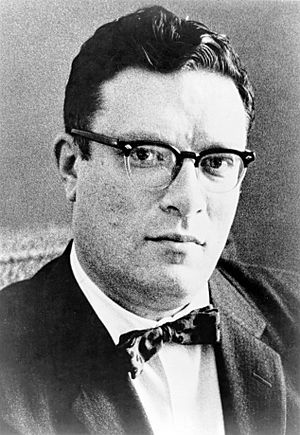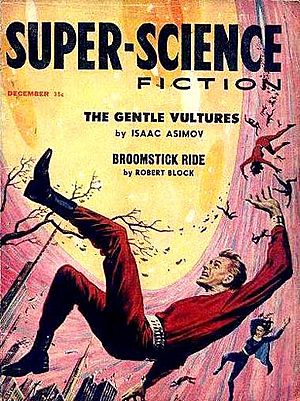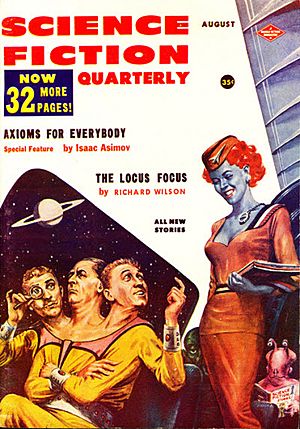Isaac Asimov facts for kids
Quick facts for kids
Isaac Asimov
|
|
|---|---|
 |
|
| Born | Isaak Ozimov Between October 4, 1919 and January 2, 1920 Petrovichi |
| Died | April 6, 1992 (aged 72) Brooklyn, New York City, U.S. |
| Occupation | Writer, professor of biochemistry |
| Nationality | Russian (early years), American |
| Education |
|
| Alma mater | Columbia University |
| Genre | Science fiction (hard SF, social SF), mystery |
| Subject | Popular science, science textbooks, essays, literary criticism |
| Literary movement | Golden Age of Science Fiction |
| Years active | 1939–1992 |
| Children | 2 |
| Signature | |
 |
|
| Scientific career | |
| Fields | Biochemistry |
| Institutions | Boston University |
| Thesis | The kinetics of the reaction inactivation of tyrosinase during its catalysis of the aerobic oxidation of catechol. (1948) |
| Doctoral advisor | Charles Reginald Dawson |
| Other academic advisors | Robert Elderfield (post-doctoral) |
Isaac Asimov was an American writer and a professor of biochemistry at Boston University. He was famous for his amazing science fiction stories and books that explained science in a simple way. Asimov wrote or edited more than 500 books. He also wrote around 90,000 letters and postcards! His books covered almost every topic, fitting into 9 out of 10 major categories of the Dewey Decimal System.
Asimov wrote a type of science fiction called hard science fiction. This means his stories were very accurate with scientific facts. He was one of the "Big Three" science fiction writers of his time. The other two were Robert A. Heinlein and Arthur C. Clarke. Asimov's most well-known works include the Foundation series, the Galactic Empire series, and the Robot series.
Besides science fiction, Asimov also wrote mysteries and fantasy stories. He wrote many non-fiction books too. Most of his popular science books explained scientific ideas by showing their history. He would start from the very beginning when the science was simplest. Some examples are Guide to Science and Understanding Physics. He also wrote about astronomy, mathematics, history, and chemistry.
Asimov was the president of the American Humanist Association. Many things are named in his honor. These include the asteroid 5020 Asimov, a crater on Mars, a school in Brooklyn, and a literary award.
Contents
Isaac Asimov's Early Life
Isaac Asimov was born in Russia into a Jewish family. The exact date of his birth is not known, but it was between October 4, 1919, and January 2, 1920. Asimov himself celebrated his birthday on January 2. When he was three years old, his family moved to the United States. He learned English and Yiddish as his first languages.
After settling in the U.S., his parents owned several candy stores. Everyone in the family had to help out. The candy stores sold newspapers and magazines. Asimov said this was a big reason he loved reading so much. He always had new books and magazines to read, which he could not have afforded otherwise. He became a U.S. citizen in 1928 when he was eight years old.
Asimov became a big fan of science fiction in 1929. He started reading the pulp magazines sold in his family's candy store. His father did not want him to read these magazines, thinking they were not good. But Asimov convinced him that because the science fiction magazines had "Science" in their name, they must be educational. When he was 18, he joined a science fiction fan club called the Futurians. There, he made friends who later became famous science fiction writers and editors.
Asimov liked small, closed spaces. He once said he wished he could own a magazine stand in a New York City Subway station. He imagined being inside it, reading, and listening to the trains rumble by.
Asimov was afraid of flying. He only flew twice in his whole life. Because of this, he rarely traveled far. This fear even showed up in some of his stories. In his later years, Asimov enjoyed traveling on cruise ships. On some cruises, he would give talks about science as part of the entertainment.
Asimov was a great public speaker. He often attended science fiction conventions, where he was friendly and easy to talk to. He patiently answered many questions and sent thousands of postcards. He was happy to give autographs. He was of medium height, a bit stocky, with mutton chop whiskers and a clear New York accent. He was not very good with his hands. He never learned to swim or ride a bicycle. However, he did learn to drive a car after moving to Boston.
In 1984, the American Humanist Association (AHA) named him the Humanist of the Year. He was also a close friend of Gene Roddenberry, who created Star Trek. Asimov even helped as a "special science consultant" for Star Trek: The Motion Picture.
Asimov said that Carl Sagan was one of only two people he met who were smarter than him. The other was Marvin Minsky, an expert in artificial intelligence. Asimov was a member and vice president of Mensa International. This is a group for people with very high IQs.
Isaac Asimov's Writings
Asimov once said that his strong need to write was like a "compulsion." He loved to sit at his typewriter and watch the words appear.
Many of Asimov's first writings were short stories. They were published in cheap science fiction and fantasy magazines. Later, most of these stories were put together into collections. Some famous collections include I, Robot, The Rest of the Robots, and Earth is Room Enough.
Other Books by Asimov
Asimov was very interested in history, not just science. Starting in the 1960s, he wrote 14 popular history books. These included The Greeks: A Great Adventure (1965) and The Roman Republic (1966).
He also published Asimov's Guide to the Bible in two parts. The first part covered the Old Testament in 1967, and the second covered the New Testament in 1969. Later, he combined them into one large book. This guide explained the history of each book of the Bible. It also talked about the political events that influenced them and shared facts about important characters. Asimov also wrote books that explained other famous literary works. These included Asimov's Guide to Shakespeare (1970).
Asimov was also a well-known mystery writer. He often wrote for Ellery Queen's Mystery Magazine. He started with science fiction mysteries, but soon wrote "pure" mysteries. He published two full-length mystery novels. He also wrote 66 stories about the Black Widowers. This was a group of men who met monthly for dinner, conversation, and to solve puzzles.
Asimov's Beliefs
Even though his family was Jewish, Asimov was an atheist. He said it took him a long time to say it out loud. He often preferred to call himself a humanist or an agnostic.
Asimov's Recommended Reading Order
Asimov made a list of 15 of his science fiction books. He suggested reading them in this order:
- I, Robot (1950). Or, The Complete Robot (1982).
- Caves of Steel (1954).
- The Naked Sun (1957).
- The Robots of Dawn (1983).
- Robots and Empire (1985).
- The Currents of Space (1952).
- The Stars, Like Dust (1951).
- Pebble in the Sky (1950).
- Prelude to Foundation (1988).
- Forward the Foundation (1993).
- Foundation (1951).
- Foundation and Empire (1952).
- Second Foundation (1953).
- Foundation's Edge (1982).
- Foundation and Earth (1986).
Books 1–5 are his 'Robot' books. Books 6–8 are his 'Galactic Empire' books. Books 9–15 are his Foundation books.
Asimov's novels have greatly influenced science fiction in TV shows and movies. His "Three Laws of Robotics" are especially famous. They have changed how people think about robots.
- A robot may not hurt a human being or, by not acting, allow a human being to be harmed.
- A robot must obey orders given to it by human beings, unless those orders go against the First Law.
- A robot must protect itself, as long as this protection does not go against the First or Second Law.
Images for kids
-
L. Sprague de Camp, Robert A. Heinlein, and Asimov (left to right), Philadelphia Navy Yard 1944
-
The first part of Asimov's Tyrann was the main story in the fourth issue of Galaxy Science Fiction in 1951. The book version was called The Stars Like Dust.
-
The first part of Asimov's The Caves of Steel on the cover of the October 1953 issue of Galaxy Science Fiction.
-
The story "Legal Rites", written with Frederik Pohl, was the only Asimov story to appear in Weird Tales.
See Also
 In Spanish: Isaac Asimov para niños
In Spanish: Isaac Asimov para niños









